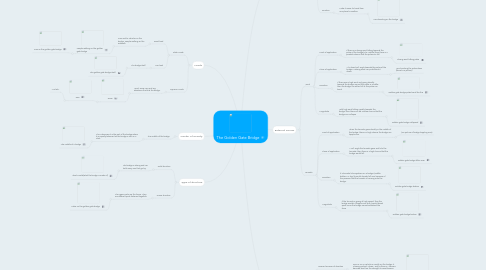
1. Loads
1.1. Static Loads
1.1.1. Dead load
1.1.1.1. Cars and/or vehicles on the bridge. People walking on the sidewalk.
1.1.1.1.1. People walking on the golden gate bridge
1.1.2. Live load
1.1.2.1. The bridge itself
1.1.2.1.1. The golden gate bridge itself.
1.2. Dynamic Loads
1.2.1. Wind, snow, rain and any substance that hits the bridge.
1.2.1.1. Snow
1.2.1.1.1. Rain
2. Center of Gravity
2.1. The middle of the bridge
2.1.1. This is because it is the part of the bridge where it is equally balanced so the bridge is not on a slant.
2.1.1.1. The middle of a bridge
3. Type of structure
3.1. Solid structure
3.1.1. The bridge is strong and can hold many cars that go by.
3.1.1.1. Steel is solid(what the bridge is made of)
3.2. Frame structure
3.2.1. The upper parts are the frame. They are different parts fastened together.
3.2.1.1. Poles on the golden gate bridge
4. Purpose, form, and Function
4.1. Purpose
4.1.1. To transport people from San Francisco to Marin Country.
4.1.1.1. The two points of San Francisco to Marin country.
4.2. Form
4.2.1. The structure is made of steel and there is 80,000 miles of cable wire.
4.2.1.1. Steel on the bridge(the whole thing)
4.2.1.1.1. Cable wire along the bridge
4.3. Function
4.3.1. Make it easier to travel from one place to another.
4.3.1.1. Cars traveling on the bridge
5. External Forces
5.1. Wind
5.1.1. Point of application
5.1.1.1. If there is a strong wind hitting towards the poles of the bridge,(The Middle) then there is a possible chance that the poles can fall.
5.1.1.1.1. Strong wind hitting poles
5.1.2. Plane of application
5.1.2.1. At a direct 90° angle towards the poles of the bridge, a strong wind can push/bend it down.
5.1.2.1.1. Wind pushing the poles down (there's no picture)
5.1.3. Direction
5.1.3.1. If there was a high wind and going directly towards the bridge around the poles or middle, then the bridge can either fall or the poles can bend
5.1.3.1.1. Golden gate bridge poles bend like this
5.1.4. Magnitude
5.1.4.1. With high wind hitting rapidly towards the bridge, then there can be a 50|50 chance that the bridge can collapse
5.1.4.1.1. Golden gate bridge collapsed
5.2. Tornado
5.2.1. Point of application
5.2.1.1. When the tornado goes directly in the middle of the bridge, there is a high chance the bridge can topple over
5.2.1.1.1. (No picture of bridge toppling over)
5.2.2. Plane of application
5.2.2.1. A 90° angle the tornado goes and hit's the tornado, then there is a high chance that the bridge would fall.
5.2.2.1.1. Golden gate bridge fallen over
5.2.3. Direction
5.2.3.1. If a tornado hits anywhere on a bridge (middle, bottom, or top) it would already fall over because of the pressure that the tornado is causing onto the bridge.
5.2.3.1.1. Golden gate bridge broken
5.2.4. Magnitude
5.2.4.1. If the tornado is going at high speed, then the bridge wouldn't topple over, but it would break apart, since the bridge cannot withstand the force
5.2.4.1.1. Golden gate bridge broken
6. Internal Forces caused by external forces
6.1. Tension because of direction
6.1.1. Since a car or vehicle is usually on the bridge, it is being pushed "down" and so there is "tension" because steal has the strength to resist tension.
6.1.1.1. Tension on a bridge
6.2. Shear because of magnitude
6.2.1. If there is a really high magnitude going on the bridge, the bridge cannot withstand the force and break apart.
6.2.1.1. Crashing into a bridge and the tand bridge breaking apart
6.3. Compression because of Magnitude
6.3.1. If something comes crashing down onto a bridge the magnitude would be high and the object would be compressing to the ground
6.3.1.1. Something crashing on top of a bridge

